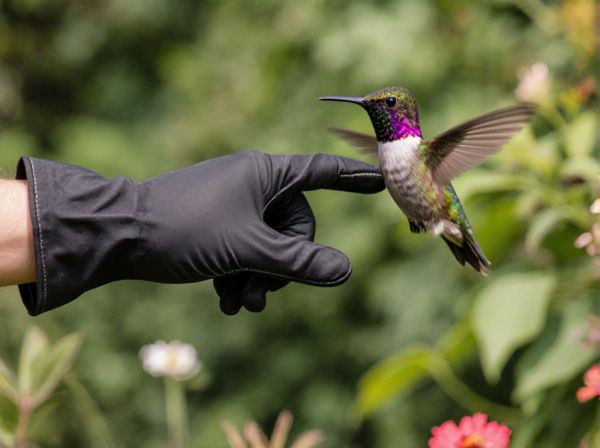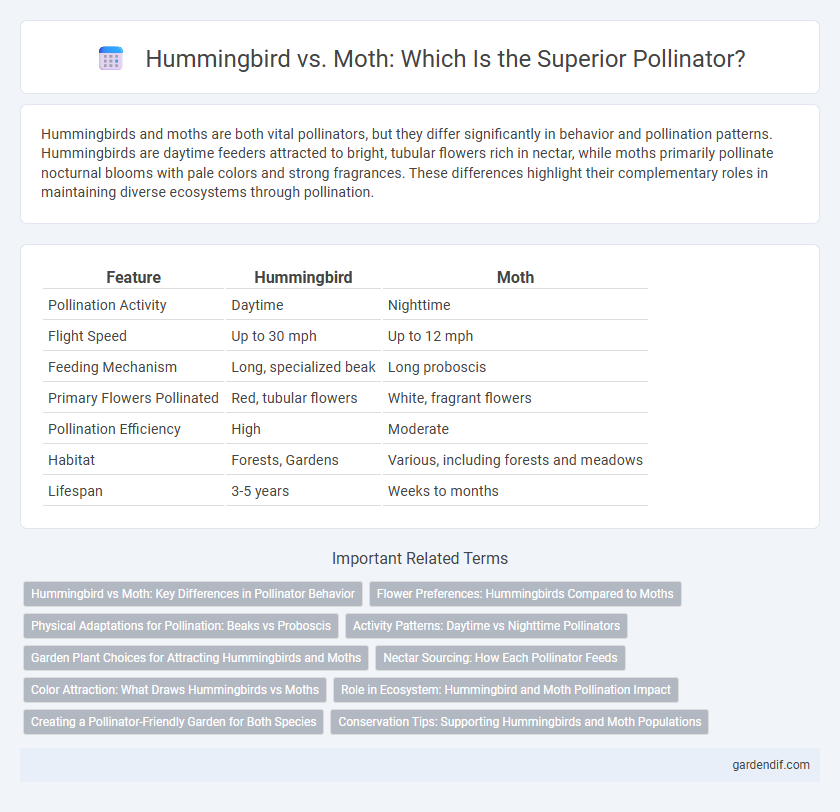
Hummingbird vs Moth Illustration
Hummingbirds and moths are both vital pollinators, but they differ significantly in behavior and pollination patterns. Hummingbirds are daytime feeders attracted to bright, tubular flowers rich in nectar, while moths primarily pollinate nocturnal blooms with pale colors and strong fragrances. These differences highlight their complementary roles in maintaining diverse ecosystems through pollination.
Table of Comparison
| Feature | Hummingbird | Moth |
|---|---|---|
| Pollination Activity | Daytime | Nighttime |
| Flight Speed | Up to 30 mph | Up to 12 mph |
| Feeding Mechanism | Long, specialized beak | Long proboscis |
| Primary Flowers Pollinated | Red, tubular flowers | White, fragrant flowers |
| Pollination Efficiency | High | Moderate |
| Habitat | Forests, Gardens | Various, including forests and meadows |
| Lifespan | 3-5 years | Weeks to months |
Hummingbird vs Moth: Key Differences in Pollinator Behavior
Hummingbirds and moths exhibit distinct pollinator behaviors driven by their physiological traits and activity patterns. Hummingbirds primarily pollinate during the day, attracted to brightly colored, tubular flowers with high nectar content, while moths are mostly nocturnal and favor pale or white flowers that emit strong fragrances at night. The rapid wing beats of hummingbirds allow precise hovering for nectar feeding, whereas moths use a long proboscis to access nectar, influencing the types of flowers each pollinator effectively services.
Flower Preferences: Hummingbirds Compared to Moths
Hummingbirds primarily favor brightly colored, tubular red or orange flowers rich in nectar, such as trumpet vine and hummingbird trumpet, which match their long beaks and hovering feeding style. Moths, especially nocturnal species, prefer pale or white flowers like evening primrose and jasmine that emit strong fragrances at night to attract them. These distinct flower preferences highlight the co-evolution of pollinators and plants, optimizing nectar accessibility and pollination efficiency for each species.
Physical Adaptations for Pollination: Beaks vs Proboscis
Hummingbirds possess long, slender beaks perfectly adapted for accessing nectar deep within tubular flowers, enabling efficient pollination. Moths utilize a coiled proboscis, which unrolls to reach nectar in similarly deep floral structures while allowing for swift, hovering flight. These specialized feeding apparatuses ensure both pollinators can effectively gather nectar and transfer pollen, supporting plant reproduction.
Activity Patterns: Daytime vs Nighttime Pollinators
Hummingbirds are primarily diurnal pollinators, actively feeding on brightly colored flowers during daylight hours, which ensures effective pollen transfer in sunny environments. Moths, on the other hand, are predominantly nocturnal pollinators, visiting pale or white flowers that open at night and emit strong fragrances to attract them in low-light conditions. This complementary activity pattern between hummingbirds and moths enhances pollination efficiency by covering a broad range of flowering periods.
Garden Plant Choices for Attracting Hummingbirds and Moths
Choosing garden plants that attract hummingbirds and moths involves selecting species with specific floral traits; hummingbirds prefer tubular, brightly colored flowers like bee balm, salvia, and trumpet vine that provide abundant nectar. Moths are drawn to pale or white night-blooming flowers such as evening primrose, datura, and jasmine that emit strong fragrances after dusk. Incorporating both types of plants creates a diverse habitat supporting pollination by these distinct yet complementary pollinators.
Nectar Sourcing: How Each Pollinator Feeds
Hummingbirds extract nectar from brightly colored, tubular flowers using their long, specialized bills and tongues designed for rapid, efficient feeding. Moths, particularly hawk moths, rely on their elongated proboscises to access nectar from deep, often nocturnal flowers with strong scents and pale colors. Both pollinators play crucial roles in their ecosystems by facilitating cross-pollination through their unique feeding adaptations.
Color Attraction: What Draws Hummingbirds vs Moths
Hummingbirds are primarily attracted to bright red and orange flowers due to their keen vision tuned to vivid colors, which signals abundant nectar. Moths, especially nocturnal species, rely more on pale or white flowers that reflect moonlight, making them visible in low-light conditions. The difference in color attraction aligns with their active periods and sensory adaptations for efficient pollination.
Role in Ecosystem: Hummingbird and Moth Pollination Impact
Hummingbirds and moths play crucial roles in pollination by facilitating gene flow among flowering plants, enhancing biodiversity and ecosystem resilience. Hummingbirds primarily pollinate bright, tubular flowers during the day, while moths contribute by targeting night-blooming plants with pale, fragrant flowers, ensuring 24-hour pollination coverage. Their complementary activities support plant reproduction, food webs, and habitat stability across diverse ecological communities.
Creating a Pollinator-Friendly Garden for Both Species
Creating a pollinator-friendly garden for hummingbirds and moths involves planting nectar-rich flowers such as trumpet vine, bee balm, and evening primrose that bloom at different times to cater to their feeding habits. Incorporating native plants and avoiding pesticides enhances habitat quality and supports pollinator health. Providing sheltered areas and shallow water sources further encourages visitation and sustains both diurnal hummingbirds and nocturnal moths.
Conservation Tips: Supporting Hummingbirds and Moth Populations
Creating pollinator-friendly habitats with native flowering plants provides essential nectar sources for both hummingbirds and moths, boosting their survival rates. Minimizing pesticide use reduces harmful chemical exposure, preserving the delicate balance of these pollinators' ecosystems. Installing hummingbird feeders and planting evening-blooming flowers can attract and support diverse moth species, enhancing local biodiversity.
Hummingbird vs Moth Infographic

 gardendif.com
gardendif.com